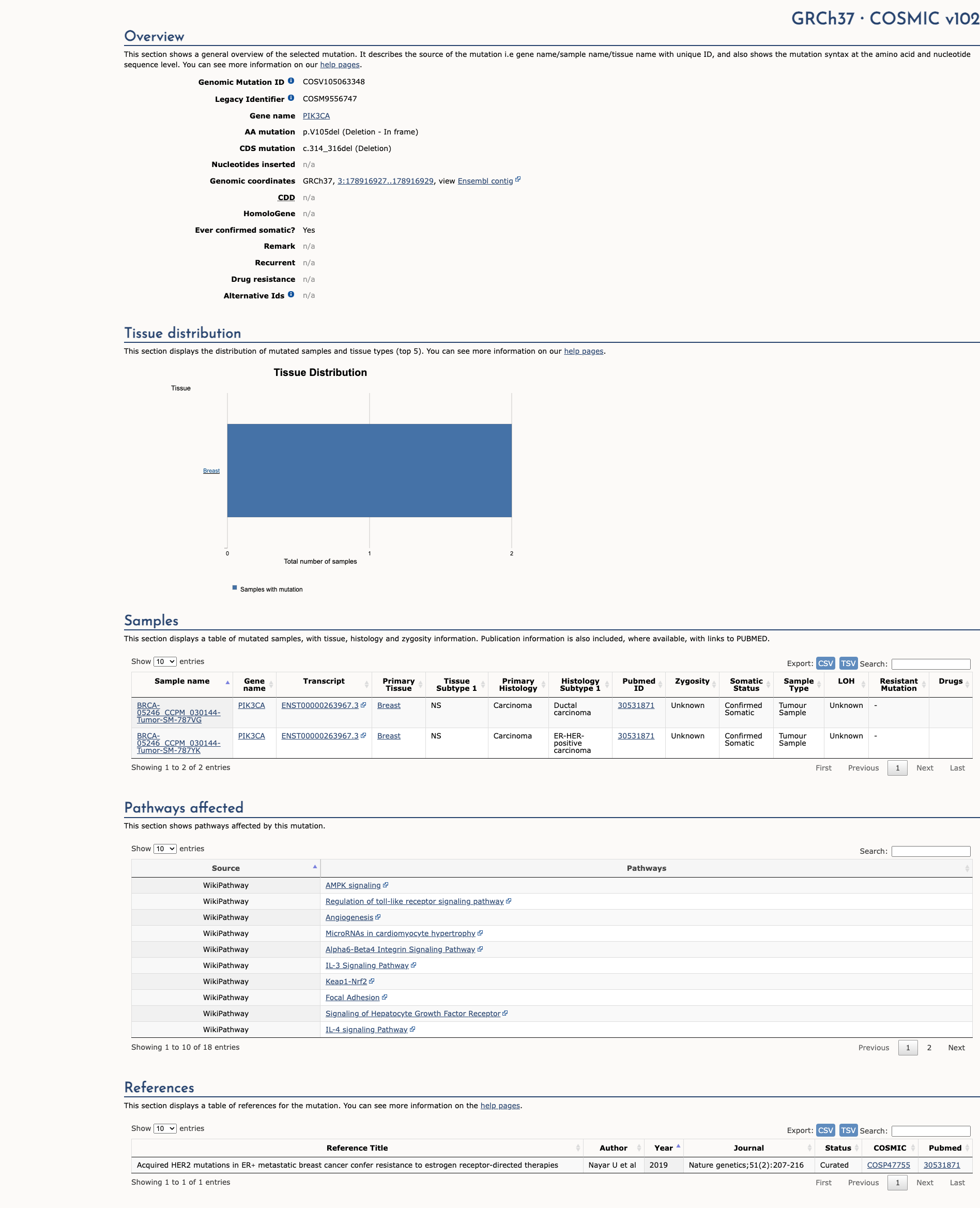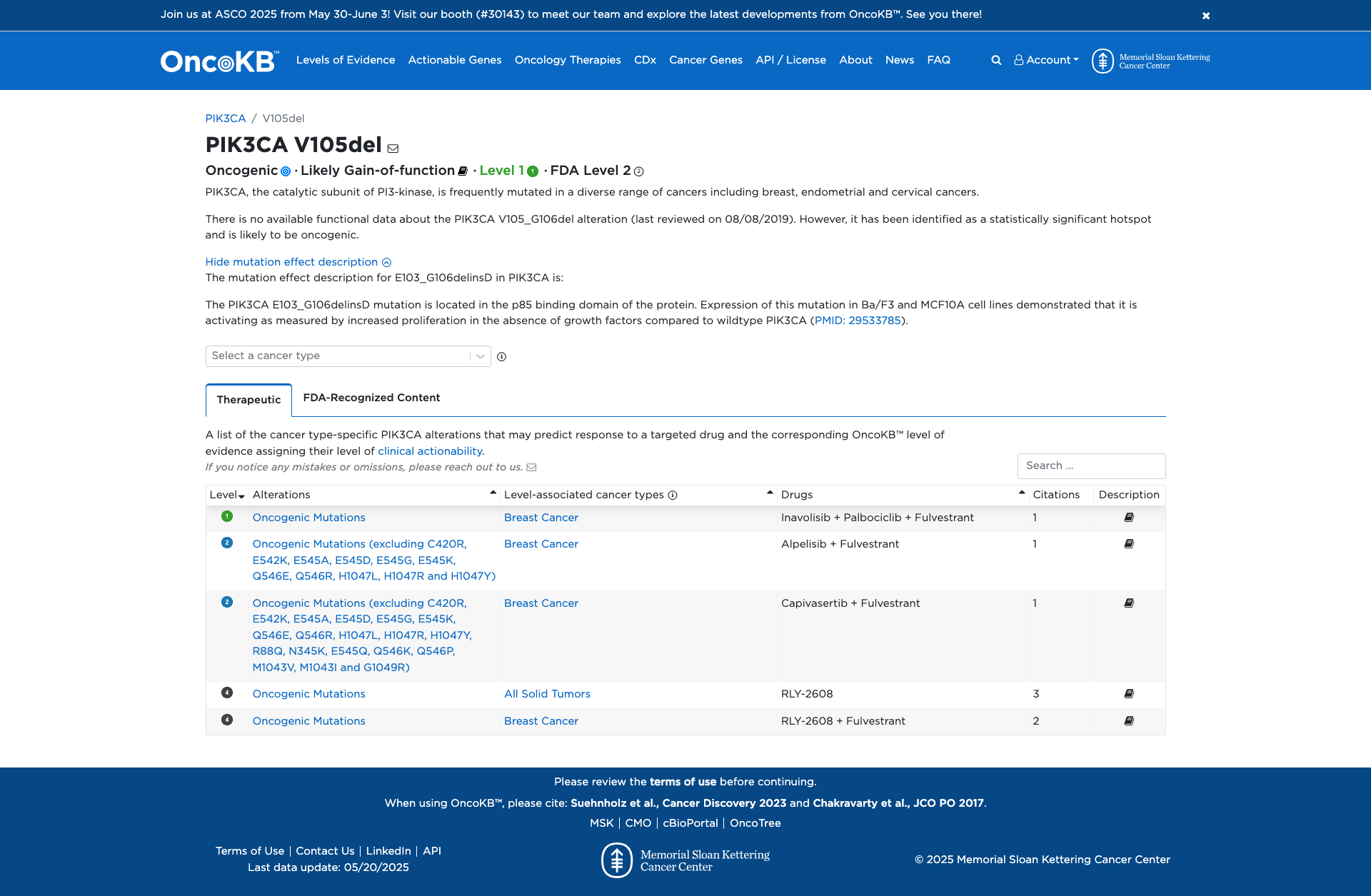PIK3CA c.314_316del, p.Val105del
NM_006218.4:c.314_316del
COSMIC ID: COSM9556748
Variant of Uncertain Significance (VUS)
The variant NM_006218.4:c.314_316delTAG (V105del) in PIK3CA is classified as a Variant of Uncertain Significance (VUS). Only PM2_Supporting (absent from controls) is met and no other criteria are satisfied, providing insufficient evidence for pathogenicity or benign classification.
ACMG/AMP Criteria Applied
PM2
Genetic Information
Gene & Transcript Details
Gene
PIK3CA
Transcript
NM_006218.4
MANE Select
Total Exons
21
Strand
Forward (+)
Reference Sequence
NC_000003.11
Alternative Transcripts
| ID | Status | Details |
|---|---|---|
| NM_006218.2 | Alternative | 21 exons | Forward |
| NM_006218.3 | Alternative | 21 exons | Forward |
Variant Details
HGVS Notation
NM_006218.4:c.314_316del
Protein Change
V105del
Location
Exon 2
(Exon 2 of 21)
5'Exon Structure (21 total)3'
Functional Consequence
Loss of Function
Related Variants
Alternate Identifiers
COSM9556748
Variant interpretation based on transcript NM_006218.4
Genome Browser
Loading genome browser...
HGVS InputNM_006218:c.314_316del
Active Tracks
ConservationRefSeqClinVargnomAD
Navigation tips: Use mouse to drag and zoom. Click on features for details.
Clinical Data
Population Frequency
Global Frequency
0.0 in 100,000
Extremely Rare
Global: 0.0%
0%
0.05%
0.1%
1%
5%
10%+
ACMG Criteria Applied
PM2
This variant is not present in gnomAD (PM2 criteria applies).
Classification
Unknown
Publications (0)
No publication details.
Clinical Statement
Functional Impact
Functional Domain
Hotspot Status
Hotspot
PM1
Mutation Count
48
Reported mutations in this domain
050100+
Domain Summary
This variant is located in a mutational hotspot or critical domain (48 mutations).
PM1 criterion applied.
Related Variants in This Domain
Computational Analysis
Pathogenicity Predictions
Predictor Consensus
Unknown
PP3 Applied
No
VCEP Guidelines
Applied ACMG/AMP Criteria (VCEP Specific) VCEP Guidelines
PVS1
PVS1 (Not Applied) Strength Modified
According to standard ACMG guidelines, the rule for PVS1 is: 'PVS1: Null variant (nonsense, frameshift, canonical ±1 or 2 splice sites, initiation codon, single exon or multiexon deletion) in a gene where loss of function is a known mechanism of disease.' The evidence for this variant shows: NM_006218.4:c.314_316delTAG is an in‐frame deletion of a single amino acid (V105del), not predicted to cause a null effect. Therefore, this criterion is not applied.
PS1
PS1 (Not Applied) Strength Modified
According to standard ACMG guidelines, the rule for PS1 is: 'PS1: Same amino acid change as a previously established pathogenic variant, regardless of nucleotide change.' The evidence for this variant shows: no previously established pathogenic variant results in a V105 deletion. Therefore, this criterion is not applied.
PS2
PS2 (Not Applied) Strength Modified
According to standard ACMG guidelines, the rule for PS2 is: 'PS2: De novo (both maternity and paternity confirmed) in a patient with the disease and no family history.' The evidence for this variant shows: no information on de novo occurrence or parental testing. Therefore, this criterion is not applied.
PS3
PS3 (Not Applied) Strength Modified
According to standard ACMG guidelines, the rule for PS3 is: 'PS3: Well-established functional studies supportive of a damaging effect on the gene or gene product.' The evidence for this variant shows: no functional assays have been performed for V105del. Therefore, this criterion is not applied.
PS4
PS4 (Not Applied) Strength Modified
According to standard ACMG guidelines, the rule for PS4 is: 'PS4: The prevalence of the variant in affected individuals is significantly increased compared to controls.' The evidence for this variant shows: no case reports or cohort data demonstrating enrichment in affected individuals. Therefore, this criterion is not applied.
PM1
PM1 (Not Applied) Strength Modified
According to VCEP guidelines, the rule for PM1 is: 'Supporting: Residues affecting critical functional domains provided in Table 4 for each gene.' The evidence for this variant shows: V105 is not listed as part of a VCEP-defined critical functional domain or mutational hotspot in PIK3CA. Therefore, this criterion is not applied.
PM2
PM2 (Supporting) Strength Modified
According to VCEP guidelines, the rule for PM2 is: 'Supporting: Absent/rare from controls in an ethnically-matched cohort population sample (≥1).' The evidence for this variant shows: c.314_316delTAG is absent from gnomAD and other population databases. Therefore, this criterion is applied at Supporting strength.
PM3
PM3 (Not Applied) Strength Modified
According to standard ACMG guidelines, the rule for PM3 is: 'PM3: For recessive disorders, detected in trans with a pathogenic variant.' The evidence for this variant shows: PIK3CA-related disorders are not recessive and no trans observations are available. Therefore, this criterion is not applied.
PM4
PM4 (Not Applied) Strength Modified
According to standard ACMG guidelines, the rule for PM4 is: 'PM4: Protein length changes due to in-frame deletions/insertions in a non-repeat region or stop-loss variants.' The evidence for this variant shows: while the variant is an in-frame deletion (V105del), there is insufficient functional or structural evidence that this length change impacts the protein. Therefore, this criterion is not applied.
PM5
PM5 (Not Applied) Strength Modified
According to standard ACMG guidelines, the rule for PM5 is: 'PM5: A novel missense change at an amino acid residue where a different missense change determined to be pathogenic has been seen before.' The evidence for this variant shows: this is an in-frame deletion, not a missense change, and no pathogenic variant at this residue exists. Therefore, this criterion is not applied.
PM6
PM6 (Not Applied) Strength Modified
According to standard ACMG guidelines, the rule for PM6 is: 'PM6: Assumed de novo, but without confirmation of paternity and/or maternity.' The evidence for this variant shows: there is no de novo or parental data. Therefore, this criterion is not applied.
PP1
PP1 (Not Applied) Strength Modified
According to standard ACMG guidelines, the rule for PP1 is: 'PP1: Cosegregation with disease in multiple affected family members in a gene definitively known to cause the disease.' The evidence for this variant shows: no segregation data are available. Therefore, this criterion is not applied.
PP2
PP2 (Not Applied) Strength Modified
According to standard ACMG guidelines, the rule for PP2 is: 'PP2: Missense variant in a gene with low rate of benign missense variation where missense variants are a common mechanism of disease.' The evidence for this variant shows: it is an in-frame deletion, not a missense variant. Therefore, this criterion is not applied.
PP3
PP3 (Not Applied) Strength Modified
According to standard ACMG guidelines, the rule for PP3 is: 'PP3: Multiple lines of computational evidence support a deleterious effect on the gene or gene product.' The evidence for this variant shows: in silico tools (SpliceAI, conservation) predict no impact; no computational evidence suggests deleterious effect. Therefore, this criterion is not applied.
PP4
PP4 (Not Applied) Strength Modified
According to standard ACMG guidelines, the rule for PP4 is: 'PP4: Patient's phenotype or family history is highly specific for a disease with a single genetic etiology.' The evidence for this variant shows: no phenotype or clinical context provided. Therefore, this criterion is not applied.
PP5
PP5 (Not Applied) Strength Modified
According to standard ACMG guidelines, the rule for PP5 is: 'PP5: Reputable source (e.g., ClinVar) reports variant as pathogenic without available evidence.' The evidence for this variant shows: not reported in ClinVar or other reputable databases. Therefore, this criterion is not applied.
BA1
BA1 (Not Applied) Strength Modified
According to standard ACMG guidelines, the rule for BA1 is: 'BA1: Allele frequency is greater than 5% in Exome Sequencing Project, 1000 Genomes or ExAC.' The evidence for this variant shows: allele frequency is 0%. Therefore, this criterion is not applied.
BS1
BS1 (Not Applied) Strength Modified
According to standard ACMG guidelines, the rule for BS1 is: 'BS1: Allele frequency is greater than expected for disorder.' The evidence for this variant shows: allele frequency is 0%. Therefore, this criterion is not applied.
BS2
BS2 (Not Applied) Strength Modified
According to standard ACMG guidelines, the rule for BS2 is: 'BS2: Observed in a healthy adult individual for a dominant disorder with full penetrance expected at an early age, etc.' The evidence for this variant shows: no healthy individual observations. Therefore, this criterion is not applied.
BS3
BS3 (Not Applied) Strength Modified
According to standard ACMG guidelines, the rule for BS3 is: 'BS3: Well-established functional studies show no damaging effect on protein function or splicing.' The evidence for this variant shows: no functional studies available. Therefore, this criterion is not applied.
BS4
BS4 (Not Applied) Strength Modified
According to standard ACMG guidelines, the rule for BS4 is: 'BS4: Lack of segregation in affected members of a family.' The evidence for this variant shows: no segregation data. Therefore, this criterion is not applied.
BP1
BP1 (Not Applied) Strength Modified
According to standard ACMG guidelines, the rule for BP1 is: 'BP1: Missense variant in a gene for which primarily truncating variants are known to cause disease.' The evidence for this variant shows: it is an in-frame deletion and PIK3CA disease mechanism is gain-of-function rather than truncating loss-of-function. Therefore, this criterion is not applied.
BP2
BP2 (Not Applied) Strength Modified
According to standard ACMG guidelines, the rule for BP2 is: 'BP2: Observed in trans with a pathogenic variant in a gene for a recessive disorder.' The evidence for this variant shows: PIK3CA is not associated with recessive inheritance and no trans data. Therefore, this criterion is not applied.
BP3
BP3 (Not Applied) Strength Modified
According to standard ACMG guidelines, the rule for BP3 is: 'BP3: In-frame deletions/insertions in a repetitive region without a known function.' The evidence for this variant shows: V105del is not located within a known repetitive region. Therefore, this criterion is not applied.
BP4
BP4 (Not Applied) Strength Modified
According to VCEP guidelines, the rule for BP4 is: 'Supporting: Award BP4 for a synonymous, intronic positions (except canonical splice sites) or non-coding variants in the UTRs if two out of three of the splicing prediction tools predicted no impact.' The evidence for this variant shows: V105del is a coding in-frame deletion, not a synonymous/intronic/UTR variant. Therefore, this criterion is not applied.
BP5
BP5 (Not Applied) Strength Modified
According to standard ACMG guidelines, the rule for BP5 is: 'BP5: Variant found in a case with an alternate molecular basis for disease.' The evidence for this variant shows: no such cases reported. Therefore, this criterion is not applied.
BP6
BP6 (Not Applied) Strength Modified
According to standard ACMG guidelines, the rule for BP6 is: 'BP6: Reputable source reports as benign without evidence.' The evidence for this variant shows: no reports from reputable sources classifying it as benign. Therefore, this criterion is not applied.
BP7
BP7 (Not Applied) Strength Modified
According to VCEP guidelines, the rule for BP7 is: 'Supporting: For synonymous, intronic positions (except canonical splice sites) and non-coding variants in the UTRs, if the nucleotide is non-conserved award this point.' The evidence for this variant shows: not a synonymous or intronic/UTR variant. Therefore, this criterion is not applied.



